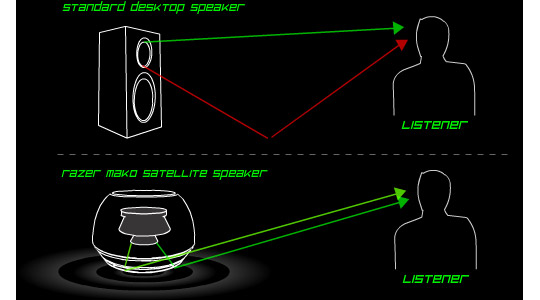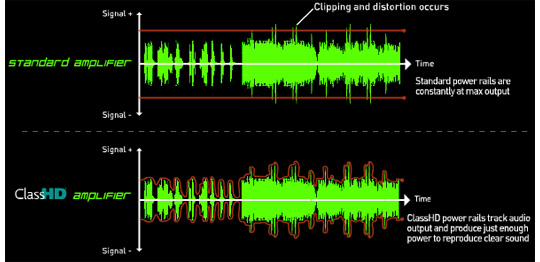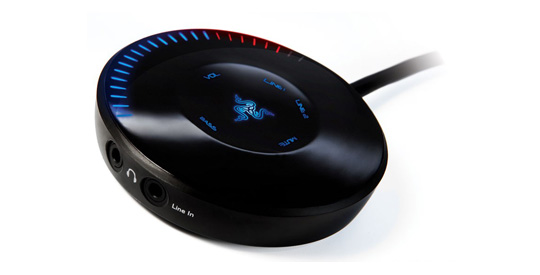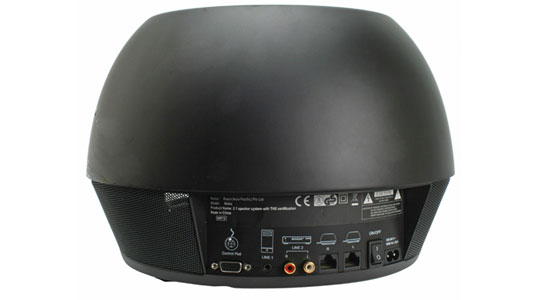Razer was kind enough to let us take a look at their Mako 2.1 channel desktop audio system. Co-designed by THX using some very special methods of aural trickery to create the best sound possible.
First up Razer and THX’s creative sleeves is what they call the THX Ground Plane and Slot Speaker technology. THX explains that this delivery system is used to eliminate the ‘desk effect’, in which audio in standard speakers not only moves directly from the driver to the listen but also ricochets off the desk below and into the sound stream. This disrupts the sound waves, muddling them down slightly. With the Mako, the drivers are actually downward-facing inside the tweeters. This forces sound to move downward out of them, bouncing off of your desk or equivalent surface and directly into your eager ears.

The second patented technology THX is using inside the Mako is their ‘Class HD’ audio processing method which actively scans the audio output for the most optimal method of eliminating background noise. Most audio systems eliminate a static range of highs and lows to get rid of background noise. The problem with this method is that in some cases, it still allows ambient noise in and in others it cuts off important audio pieces. With Class HD, the Mako scans the output and constantly adjusts to maximize the elimination of background noise while minimizing the loss of important audio information.

The control pad included with the Mako is definitely one of those ‘whiz-bang’ devices, utilizing a touch-pad interface. One arc of the cylindrical pad is the volume indicator. Brilliant blue hash lines turn to red the higher you push the levels. Changing levels is as simple as rubbing your finger on the front of the pad in the direction you wish the level to go. It doesn’t take much to change and was surprisingly responsive. Also on the control are touch-pad buttons to change the volume indicator to a bass indicator and back. This will allow you to change the amount coming from the sub woofer. Another cool feature of the Mako is that it accepts a second input line from another audio source. Switching between the two inputs is accomplished through a touch-pad button on the controls as well. The final topping on the scrumptious cake which is the Mako’s control pad is the headphone jack. This makes going into stealth mode much easier as the Mako has a tendancy to get away from you in terms of volume. The sound is so crisp you just have to pump it up to the next volume hash mark to see if it distorts. Thankfully, getting the Mako to distort is VERY difficult to accomplish.
Some reviewers claim the Mako’s bass levels are not ‘thumping’ as much as they like. To this, we respond that true music lovers know that producers often load down a band’s audio tracks with bass to cover-up other ‘chinks’ in the band’s performance-armor. Also, speaker-developers will sometimes increase the bass response in their units as a cover-up to the higher-end shortcomings. The Mako reproduces music as faithfully to the original performance as possible. While not appropriate to rattle your neighbor’s windows the Mako could make them think there was a live band playing in your living room or office.
The Mako has been designed with Razer’s sense of style in mind. The sub woofer is a black dome-like structure with a flat top harboring the Razor logo while on the front is the THX name. The back of the sub woofer features all of the units inputs and outputs. There you will find the power input, satellite speaker outputs, control pad input, audio input and power switch. To make the Mako even more flexible, white and red stereo audio inputs are also available in this area of the sub. The two satellite speakers are attached using what appears to be Cat 5 network cable, although not quite as standard Cat 5 cable will not work, and look like the smaller offspring of the sub woofer in design and style.
The Mako’s greatest shortcoming is its price point. At an MSRP of $399 dollars, they are just too expensive for the average PC gamer these days. Once you can save up for them though, we can’t recommend them enough. It is the kind of thing like how standard-definition commercials were trying to demo high-definition signal – it is just not possible. The best way to get a feel for them is to hear them, either at a trade show or your friend which has them or perhaps even a commercial retailer if possible. Once you do hear them, you will begin the process of saving your pennies. They are really that good.




